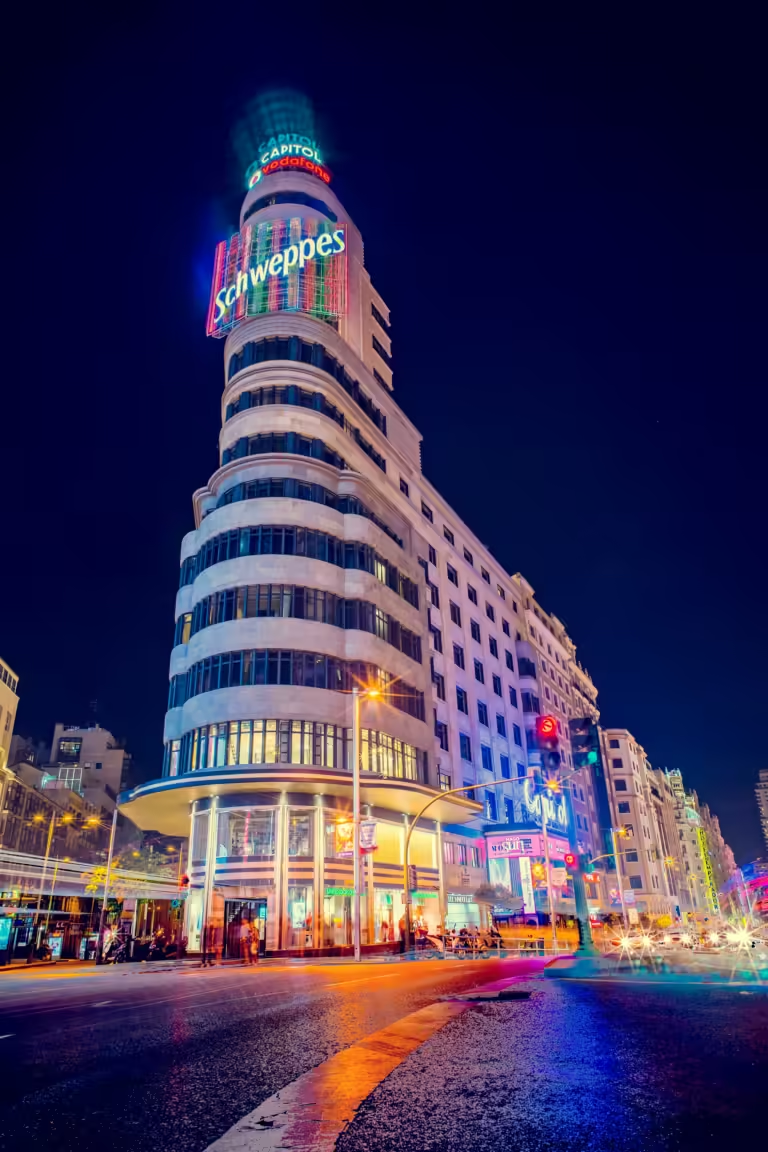Galleria Vittorio Emanuele II
One of the most magnificent and oldest shopping malls in Italy, Galleria Vittorio Emanuele II is located in the heart of Milan and is a symbol of luxury and rich history. Built in the 19th century and named after Victor Emmanuel II, the first king of a unified Italy, this monument is not just a shopping mall, it is an architectural masterpiece that combines art, culture and shopping.
Opened in 1877, the Galleria Vittorio Emanuele II was designed by the famous architect Giuseppe Mengoni. The building is famous for its stunning glass roof and iron domes, making it a visually stunning sight that attracts visitors from all over the world. The Galleria is an ideal place for high-end shopping, as it houses a collection of the world’s finest stores and fine dining restaurants.
In addition to its role as a shopping center, the Galleria plays an important cultural role in the city of Milan. It is not only a shopping center, but also a place where locals and tourists gather to celebrate special events and occasions. Art exhibitions and concerts are held in the Galleria, which enhances its cultural significance.
Galleria Vittorio Emanuele II is also a major tourist attraction in Milan. Visitors flock to see the magnificent architectural details and the unique experience it offers. As they wander through the grand corridors, they can admire the beauty of the mosaics and artistic decorations that adorn the floors and walls. A visit to the Galleria is undoubtedly an unforgettable experience that combines history, art, culture and shopping in one place.
The Mysterious Legend Behind the Bull Mosaic
In the center of the famous Galleria Vittorio Emanuele II in Milan, Italy, there is a mosaic depicting a bull. This mosaic is not just a piece of art, but also carries a mysterious legend. Local legend says that placing your right foot on a specific area of the bull and spinning around yourself three times will bring good luck. This tradition attracts thousands of tourists every year, who hope to bring good luck into their lives.
But is there any historical evidence to support this myth? In fact, no historical records have been found that indicate the exact origin of this practice. It is believed that this custom began in the early 20th century, and may have been simply an attempt to attract more visitors to the Galleria. However, the idea itself may have been inspired by ancient traditions that believed in the power of animal symbols.
The bull mosaic itself is part of a group of mosaics representing symbols of different cities in Italy. The bull symbolizes the city of Turin, a city with a long history and rich culture. The choice of the bull in particular may have something to do with the animal’s reputation for strength and courage, lending further credence to the idea of bringing good luck.
Regardless of the origin of the legend, it has become an integral part of Milan’s tourist culture. Visitors from all over the world come to take part in this ritual, making the bull mosaic one of the most famous landmarks in the Galleria. Although there is no solid historical evidence to support the idea, popular belief in it continues to grow, adding another layer of magic and mystery to this unique place.
Tourist Experience: How the Bull Attracts Visitors
The Bull Mosaic in Galleria Vittorio Emanuele II is a prominent tourist attraction that attracts visitors from all over the world. Tourists flock to this historic site in Milan not only to admire the architectural beauty, but also to experience the unique rituals associated with this legendary bull. This tourist experience is one of the most intriguing activities that adds a touch of mystery to a visit to the city.
The ritual begins with the visitor standing on the heel of his right foot over the testicle depicted in the mosaic, and then he must spin around himself three times. Many believe this act brings good luck, and is part of the legend surrounding the bull. This simple ritual attracts tourists of all generations, from children who enjoy the twirl to adults looking for a heritage and cultural experience.
Many visitors talk about the impact this experience has had on their trip to Milan. Some visitors describe it as a special moment that makes their visit special and makes them feel like they are part of local history. Others see this ritual as a unique photo opportunity that adds to their travel memories. Regardless of the purpose of visiting Galleria Vittorio Emanuele II, the experience of standing on the bull and spinning around has become an integral part of the city’s tourist experience.
The Bull Mosaic attracts visitors not only for its mythology but also for its ability to bring people together from different cultures and backgrounds. It is an experience that combines fun, curiosity and a desire to explore the unfamiliar, making it one of the most unforgettable experiences in Milan.
The cultural and social impact of myth
The legend of the bull mosaic in the Galleria Vittorio Emanuele II is not only a good luck charm, but also has profound effects on local culture and the tourist trade in Milan. This legend is an integral part of the city’s cultural identity, with visitors and tourists from all over the world flocking to experience this special ritual.
Culturally, this legend is a living example of how history blends with the daily life of the local community. Locals celebrate their heritage by practicing this ritual, while telling stories about its origins and history to new generations and tourists alike. This cultural inheritance enhances the sense of belonging and identity of the residents, and enriches the social fabric of the city.
Commercially, the legend of the bull mosaic has greatly contributed to Milan’s tourism. The Galleria Vittorio Emanuele II is one of the city’s most prominent tourist destinations, and the ritual of twirling on the bull mosaic is an integral part of any visitor’s tour of Milan. This ritual attracts thousands of visitors each year, which positively impacts the local economy by increasing footfall at the shops, restaurants and hotels surrounding the galleria.
In addition, this legend adds an extra dimension of charm and attraction to Milan, enhancing its position as a global tourist destination. Tourists who participate in this ritual return home with unique stories and experiences, which contributes to spreading the city’s fame and attracting more visitors in the future.
Experts and historians' opinions about the legend
The bull mosaic in the Galleria Vittorio Emanuele II is one of the folkloric phenomena that has intrigued many historians and experts in Italian culture. This mosaic, dating back to the 19th century, shows a bull being swung around by visitors as a ritual believed to bring good luck. But what is the real origin of this legend and what are its scientific or historical explanations?
Many historians suggest that this tradition may have been inspired by ancient practices dating back to Roman times, when the bull was a symbol of strength and fertility. At that time, people believed that circling around a bull statue could bring good luck and success. This idea may have evolved over the centuries and transformed into the modern folklore we see today in the Galleria Vittorio Emanuele II.
On the other hand, some folklorists believe that the legend may be the result of an interaction between popular beliefs and tourism practices. Over time, the mosaic became a tourist attraction, which contributed to strengthening the legend and making it an integral part of the experience of visiting the Galleria. This phenomenon shows how culture can evolve and transform due to social and economic influences.
Another analysis comes from anthropologists who see in this legend an example of how ancient symbols can be used in modern contexts. They believe that the bull in the mosaic is not just a symbol of good luck, but a representation of a set of values and beliefs that have been embodied in Italian culture over generations. They believe that this type of folklore contributes to strengthening cultural identity and serves as a means of linking the present with the past.
Regardless of which analysis is adopted, it remains clear that the bull mosaic in the Galleria Vittorio Emanuele II is more than just a piece of art; it is a cultural symbol that carries within it many connotations and meanings that transcend time and geography.
Personal stories and experiences
There are many stories and personal experiences of people who have visited the Galleria Vittorio Emanuele II, where the bull mosaic left deep and varied impressions. Among the positive experiences, Sarah, a tourist from Germany, tells us how she performed the famous ritual of standing on her heels and spinning three times over the bull, and felt a flood of good luck after her visit. Sarah says: “After performing the ritual, I received good news about being accepted for a job application in a prestigious company, and since then I have come to believe in the power of this place.”
On the other hand, we have the story of Marco, a college student from Italy, who visited the Galleria with his friends. Although he did not believe in myths, he decided to participate in the ritual just for fun. “I thought it was just a superstition, but after the experience, I noticed an unexpected improvement in my academic performance,” Marco says.
On the other hand, there are negative experiences as well. Julie, a tourist from England, tells us how after performing the ritual she felt bad luck following her. Julie says: “After visiting the Galleria and performing the ritual, I had a small car accident, and although it wasn’t serious, it made me feel pessimistic.”
Another unique experience was that of Liam, an expat living in Milan. Liam undertook the ritual on the recommendation of his friends, and says: “I didn’t notice any major changes in my life, but I felt immersed in Italian culture and experienced it from a different perspective.”
These personal stories and experiences reflect the diversity of feelings and impressions about the Bull Mosaic in the Galleria Vittorio Emanuele II. The contrasting stories, whether positive or negative, add a human dimension to the legend and make it an integral part of Milan’s living heritage.
Compared to similar legends around the world
Myths are an integral part of the cultural heritage of every society, contributing to the formation of collective identity and the transmission of values and beliefs across generations. When comparing the myth of the bull mosaic in the Galleria Vittorio Emanuele II with similar myths around the world, we find similarities and differences in rituals, meanings and connotations.
In ancient Greek culture, we find the famous myth of the Minotaur, a creature half man and half bull, who lived in an intricate labyrinth on the island of Crete. Human sacrifices were offered to him as part of religious rituals, reflecting complex symbolic dimensions related to the conflict between man and nature, as well as between reason and instinct.
In Middle Eastern cultures, we find the legend of the sacred bull Apis in ancient Egypt. The Apis bull was considered the incarnation of the god Ptah, one of the main deities in Egyptian mythology. Rituals associated with Apis included offering sacrifices and grand celebrations, which expresses the ancient Egyptians’ reverence for animals and their role in religious and social life.
In Asia, we find the legend of Nandi, the sacred bull in Hinduism, which is considered the vehicle of the god Shiva. Nandi is associated with fertility, strength and protection, and is considered a symbol of positive energy. Rituals related to Nandi include offering flowers and fruits and performing circumambulation around his statue, reflecting the deep respect for nature and animals in Hindu culture.
Through this comparison, it becomes clear that the myths related to the bull share some general features such as high symbolism and religious ritual, but differ in details and cultural purposes. The myth of the bull mosaic in the Galleria Vittorio Emanuele II reflects a unique aspect of Italian heritage, where mosaics are used as a means of linking the present with the past and adding a touch of magic to everyday life.
Tips for new visitors
If you are planning to visit Galleria Vittorio Emanuele II and experience the famous bull ritual, there are a few tips that can help you get the most out of this unique experience. First, it is best to visit the galleria early in the morning or late in the evening to avoid the large crowds. These are the times when the galleria is less crowded, allowing you to enjoy the beauty of the mosaics and the magnificent architecture without jostling with other tourists.
Secondly, if you want to experience the bull ritual that involves spinning on your heels over the bull mosaic, make sure you wear comfortable shoes. This may seem like an obvious tip, but having comfortable shoes makes it easier to spin steadily and adds a lot of fun to your experience. Also, be prepared to wait a little if there is a line of tourists waiting for their turn.
Third, don’t forget to take pictures! Galleria Vittorio Emanuele II is one of the most beautiful tourist places in Milan, and your photos here will be unforgettable memories. Try to capture the different angles of the galleria in addition to your personal shots during the ritual to document this special moment.
Finally, take some time to explore the luxury shops and cafes in The Galleria. After experiencing the bull ritual, you can relax in one of the cafes and enjoy a cup of authentic Italian coffee or shop in one of the luxury stores. This way, you will have enjoyed a comprehensive experience that combines culture, history, and shopping.






